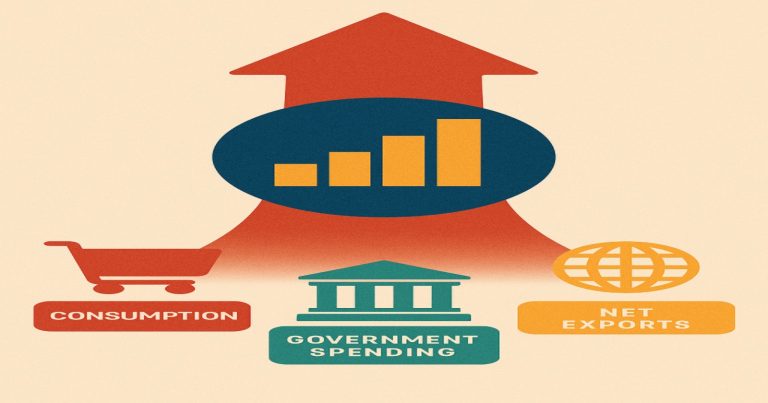Aggregate Demand and Its Components are essential concepts in macroeconomics that describe the total demand for goods and services in an economy at a given overall price level and within a specified period. Aggregate demand represents the sum of all expenditures on a nation’s goods and services. It is a crucial determinant of economic activity and is influenced by various factors such as income levels, consumer confidence, government policies, and global economic conditions.
What is Aggregate Demand?
Aggregate Demand (AD) refers to the total quantity of goods and services demanded in an economy at a given price level and over a certain period of time. It is the sum of consumption expenditure, investment expenditure, government spending, and net exports (exports minus imports).
Economists view aggregate demand as a downward-sloping curve when plotted against the price level, which shows the inverse relationship between the price level and the total quantity of output demanded. When the price level falls, the purchasing power of consumers increases, leading to higher demand for goods and services, and vice versa.
The Formula for Aggregate Demand
The formula for Aggregate Demand is given as:
AD=C+I+G+(X−M)AD = C + I + G + (X – M)
Where:
- CC is Consumption Expenditure
- II is Investment Expenditure
- GG is Government Spending
- (X−M)(X – M) represents Net Exports (Exports minus Imports)
Each of these components plays a crucial role in determining the overall demand in the economy.
The Components of Aggregate Demand
Aggregate demand consists of four main components:
1. Consumption (C)
Consumption refers to the total spending by households on goods and services in an economy. It includes both durable goods (such as cars, furniture, and electronics) and non-durable goods (such as food, clothing, and healthcare services). Consumption is influenced by factors like income levels, interest rates, consumer confidence, and wealth.
- Key Factors Affecting Consumption:
- Income: Higher income leads to more disposable income, which increases consumption.
- Interest Rates: Lower interest rates reduce the cost of borrowing, increasing household consumption.
- Consumer Confidence: If consumers feel optimistic about the future, they are likely to spend more.
- Wealth Effect: If consumers’ wealth increases (e.g., due to rising house prices or stock market gains), they tend to spend more.
2. Investment (I)
Investment refers to the spending by businesses on capital goods, such as machinery, equipment, and buildings, which are used to produce goods and services. Investment is a vital component of aggregate demand because it contributes to the productive capacity of the economy.
- Key Factors Affecting Investment:
- Interest Rates: Higher interest rates increase the cost of borrowing, leading to lower levels of investment. Conversely, lower interest rates encourage investment.
- Business Confidence: When businesses expect strong future demand, they are more likely to invest in new projects.
- Government Policies: Tax incentives, subsidies, or changes in regulations can encourage or discourage business investment.
3. Government Spending (G)
Government Spending is the expenditure by the government on goods and services, including infrastructure projects, defense, healthcare, education, and public services. Government spending can significantly influence aggregate demand because it directly increases the demand for goods and services in the economy.
- Key Factors Affecting Government Spending:
- Fiscal Policies: Governments use fiscal policy (adjustment of government spending and taxes) to manage aggregate demand. Expansionary fiscal policy (increased spending or tax cuts) raises aggregate demand.
- Public Investment: Spending on infrastructure, such as roads, bridges, and schools, creates jobs and stimulates demand in the economy.
- Government Borrowing: Increased borrowing by the government can lead to higher spending, thus increasing aggregate demand.
4. Net Exports (X – M)
Net Exports represent the difference between a country’s exports (X) and imports (M). A positive net export means that the country is exporting more than it is importing, which adds to aggregate demand. Conversely, a negative net export means that the country is importing more than it is exporting, which reduces aggregate demand.
- Key Factors Affecting Net Exports:
- Exchange Rates: A depreciation of the currency makes exports cheaper for foreign buyers, leading to an increase in exports and, thus, aggregate demand.
- Global Economic Conditions: Strong economic growth in trading partner countries can increase demand for exports.
- Domestic Economic Performance: If the domestic economy is doing well, imports may increase, reducing net exports.
The Determinants of Aggregate Demand
While the components of aggregate demand are relatively straightforward, several external factors can influence its overall level in the economy:
1. Changes in Consumer Expectations
When consumers expect higher income or better economic conditions in the future, they tend to increase their current consumption, which increases aggregate demand. On the other hand, pessimistic expectations can lead to reduced consumption.
2. Changes in Interest Rates
Interest rates are a critical determinant of both consumption and investment. A reduction in interest rates makes borrowing cheaper, encouraging both consumers and businesses to spend more, which boosts aggregate demand.
3. Government Policies
Governments can influence aggregate demand through fiscal policies (changes in government spending or taxes) and monetary policies (influencing interest rates or money supply). An increase in government spending or tax cuts leads to a rise in aggregate demand, while higher taxes or reduced government spending can reduce demand.
4. Global Economic Conditions
Global economic conditions can have a significant impact on a country’s aggregate demand. For example, during periods of global economic expansion, a country may see increased demand for its exports, contributing to higher net exports and a rise in aggregate demand.
Conclusion
Aggregate Demand and Its Components provide a comprehensive picture of the overall demand for goods and services in an economy. The four components—consumption, investment, government spending, and net exports—work together to determine the level of economic activity and influence the macroeconomic equilibrium. Policymakers closely monitor aggregate demand as it directly impacts economic growth, inflation, and employment levels. Understanding the components of aggregate demand is crucial for analyzing the health of an economy and making informed decisions regarding fiscal and monetary policies.
Aggregate Demand and Its Components FAQs
What is aggregate demand?
Aggregate demand is the total demand for goods and services in an economy at a given price level over a specified period. It is the sum of consumption, investment, government spending, and net exports.
What are the four components of aggregate demand?
The four components of aggregate demand are: Consumption (C)
Investment (I)
Government spending (G)
Net exports (X – M)
How do interest rates affect aggregate demand?
Interest rates influence both consumption and investment. Lower interest rates make borrowing cheaper, which encourages consumers to spend more and businesses to invest, thus increasing aggregate demand.
What role does government spending play in aggregate demand?
Government spending directly increases aggregate demand by purchasing goods and services or investing in public infrastructure, which stimulates economic activity.
How do net exports affect aggregate demand?
Net exports (exports minus imports) contribute to aggregate demand. A positive net export (more exports than imports) increases aggregate demand, while a negative net export decreases it.


